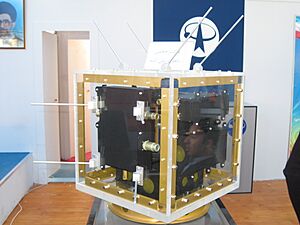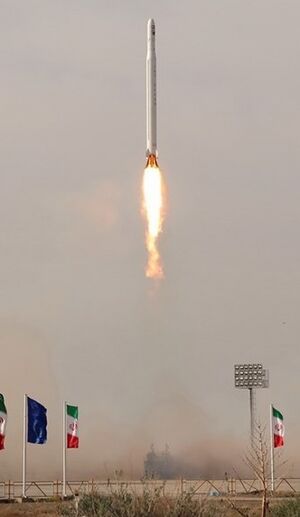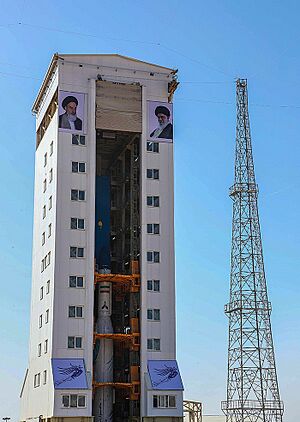Iranian Space Agency facts for kids

Official logo of ISA
|
|
| Agency overview | |
|---|---|
| Abbreviation | ISA |
| Formed | 1 February 2004 |
| Type | Space agency |
| Headquarters | Tehran, Mahdasht, Semnan, Shahrud, Qom |
| Administrator | Hassan Salarieh |
| Primary spaceport | Imam Khomeini Spaceport |
| Owner | Ministry of Information and Communications Technology of Iran |
| Annual budget | ~$ 222 million (2024) |
The Iranian Space Agency (ISA) is Iran's official space agency. It's like Iran's NASA, working on space research and missions. The ISA and the Iranian Space Research Center are the main groups that handle space activities in Iran. Iran became a country that could launch its own satellites into orbit in 2009. Iran was also one of the first 24 countries to help start the United Nations Committee on the Peaceful Uses of Outer Space (COPUOS) in 1958.
Contents
History of Iran's Space Program
The story of Iran's space efforts began in the late 1940s and early 1950s. Iran first started using space technology in 1960. It joined the International Satellite Communications Organization. Iran also set up a special antenna in Asadabad, Hamedan, to use satellite communications.
In 1974, after the first US Earth Resources Survey satellite was launched, Iran created an office to use satellite data. This office helped Iran use remote sensing technology. Later, this office became the "Iranian Remote Sensing Center." This was the start of a national space group in Iran in the early 1970s.
In 1976, the "Iran Remote Sensing Center" bought and set up stations in Mahdasht, Karaj. These stations could directly receive satellite information. They also processed, copied, and shared this data.
In 1991, the "Iranian Remote Sensing Center" became a state-owned company. It moved under the Ministry of Posts, Telegraphs, and Telephones. Later, all its main activities were moved to the Iranian Space Organization.
The ISA was officially created on February 28, 2004. This happened after a law was passed in 2003. The ISA's job is to manage all peaceful space activities in Iran. It works under a Supreme Council of Space, led by the President of Iran.
The council's main goals included making plans for using space technology peacefully. They also aimed to build and launch national research satellites. The council wanted to encourage private companies to get involved in space. They also worked on international cooperation in space.
The ISA works with the Ministry of Information and Communications Technology of Iran. The head of the ISA is also a Vice-Minister. This person also leads the Supreme Council of Space.
Iran's space program was paused in 2015 due to international pressure. However, it was restarted in 2021.
Space Budget
The money set aside for Iran's space program changes over time. For the Iranian year 1393 (2014–2015), the proposed budget was about US$71.7 million. The Iranian Space Research Center also received an extra US$67.3 million.
In 2008, the budget was mentioned as US$3.9 billion. It was not clear if this was for one year or a longer time. By 2017, the proposed budget for the Iranian Space Agency dropped to about US$4.6 million.
Satellite Launch Vehicles (SLVs)
Iran has developed several rockets to send satellites into space. These are called Satellite Launch Vehicles, or SLVs.
Safir SLV
The Safir SLV is a rocket that Iran developed. It is 22 meters tall and has two stages. Each stage uses liquid fuel. The first stage is a longer, more powerful version of the Shahab-3C rocket. The Safir SLV weighs over 26 tons when it lifts off.
The Safir-1B is an improved version of the Safir SLV. It can carry a satellite weighing 60 kilograms. It can place satellites into an elliptical orbit between 300 and 450 kilometers high. The engine's power for the Safir-1B was increased from 32 to 37 tons.
Simorgh SLV
In 2010, Iran built a more powerful rocket called Simorgh. This rocket is designed to carry heavier satellites into orbit. The Simorgh rocket is 27 meters (89 feet) long. It weighs 77 tonnes (85 tons).
Its first stage has four main engines. Each engine creates a lot of thrust. There is also a fifth engine for controlling the rocket's direction. At liftoff, all these engines create a total of 130,000 kilograms (286,600 pounds) of thrust. The Simorgh can put a 350-kilogram (770-pound) satellite into a 500-kilometer (310-mile) low Earth orbit. The first flight of the Simorgh rocket happened on April 19, 2016.
Zuljanah SLV
On February 1, 2021, Iran announced a successful test of its newest satellite launch vehicle, "Zuljanah". This rocket can carry satellites weighing up to 220 kilograms. It can place them into a 500-kilometer orbit. The Zuljanah SLV has three stages. It uses two solid fuel engine stages and one liquid fuel stage. The first and second stages each have 75 tons of thrust.
Qaem 100 SLV
The Qaem 100 is another satellite launch vehicle developed by Iran.
Qased SLV
The Qased is also one of Iran's satellite launch vehicles.
Qoqnoos SLV
On February 2, 2013, the head of the Iranian Space Agency, Hamid Fazeli, said that a new rocket called Qoqnoos would be used. This rocket is planned to carry even heavier satellites after the Simorgh SLV.
Soroush 1 & 2 SLV
The ISA plans to build two more SLVs in the future. They are named "Soroush" 1 and 2. These rockets are designed to carry very heavy payloads into space. Soroush 1 could carry 8 tons, and Soroush 2 could carry 15 tons. They would place these payloads into a 200-kilometer orbit.
Launch History
Iran has launched several rockets and satellites into space.
Orbital Launches
On August 17, 2008, Iran launched a test of its two-stage Safir SLV. This launch happened from a site near Semnan city. Reza Taghizadeh, head of the Iranian Aerospace Organization, said they successfully launched a dummy satellite into orbit for the first time.
On February 2, 2009, Iran successfully launched its first satellite made in the country. The satellite was named Omid, which means "Hope." It was launched into Low Earth orbit by Iran's Safir rocket. This made Iran the 9th country to put its own satellite into orbit. This launch happened during the 30th anniversary of the Iranian Revolution.
In February 2011, Iran's president announced that many more satellites would be launched in 2011–2012. Iran plans to send one-ton satellites into an orbit of 1000 kilometers. For this, they are building a new launch base. Iran also plans to launch satellites into orbits up to 36,000 kilometers by 2027.
Sub-orbital Launches
On February 25, 2007, Iran announced a successful launch of a rocket. This rocket carried an unknown cargo. It might have been the first test flight of the three-stage Safir SLV, which failed. Later, Iran's President said the failure was due to a technical problem.
On February 4, 2008, Iran successfully launched a two-stage rocket called Kavoshgar-1 (Explorer-1). This was a test flight from its new launch complex in Shahroud. The first part of the rocket separated and returned to Earth with a parachute. The second part reached 200 kilometers high. The third part, with a probe, went up to 250 kilometers. It sent back scientific data about the atmosphere.
The second Kavoshgar (Kavoshgar-2), which carried a space-lab, was launched in November 2008. In 2016, 2017, 2019, and 2020, Iran launched a sub-orbital satellite on Simorgh. In 2021 and 2022, it launched a satellite on Zuljanah, both successfully.
Animals in Space
Iran is the 6th country to send animals in space.
- On February 3, 2010, the ISA launched a Kavoshgar-3 (Explorer-3) rocket. It carried a rodent, two turtles, and several worms into space. They returned to Earth alive. The rocket could send electronic data and live video back to Earth. This was Iran's first launch with living creatures.
- On March 15, 2011, the ISA launched the Kavoshgar-4 (Explorer-4) rocket. It carried a test capsule designed for a monkey, but no animals were on board.
- A mission with Kavoshgar-5 (Explorer-5) carrying a live monkey failed in September 2011. Iran then paused these plans.
- On January 29, 2013, Iran announced that a monkey was sent into space and returned safely. This happened aboard the Pishgam capsule. The monkey reached a height of 120 kilometers. This was the first time Iran sent a primate into space.
- On December 14, 2013, Iran launched a second monkey, named Fargam. This was also a short flight. The monkey was retrieved safely.
- On December 6, 2023, Iran launched a 500-kilogram (1,000-pound) bio-space capsule. It went 130 kilometers (80 miles) from Earth. This was a test for space technologies.
Satellites
Iran is the 9th country to put its own satellite into orbit using its own rocket.
Launched Satellites

- On October 28, 2005, a Russian rocket launched Sina-1. This project cost US$15 million. Iran became the 43rd country to have its own satellite.
- Huanjing (Environment) 1 was a joint satellite with China and Thailand. It launched on September 6, 2008. It helps with natural disasters like floods and earthquakes.
- Omid, Iran's first satellite launched by its own rocket, was sent into orbit in February 2009. It was for research and communications.
- Rasad-1 is an imaging satellite built by Iran. It launched on June 15, 2011. It sent back pictures with 150-meter resolution. It fell out of orbit three weeks later.
- Navid-e Elm-o Sanat was an "experimental satellite" built by students. It launched on February 3, 2012. It stayed in orbit for two months.
- Fajr is an imaging satellite with a GPS system. It launched on February 2, 2015. It reentered Earth's atmosphere after 23.8 days.
- Toloo is a new generation of detector satellites. It was launched on a Simorgh rocket but did not reach orbit successfully.
- Dousti, an Earth observation satellite, launched on February 5, 2019. The launch failed.
- Payam (formerly AUT-SAT) is a small satellite for remote sensing. It launched on January 15, 2019, but failed to reach orbit.
- On February 9, 2020, Iran launched the communication satellite, Zafar 1. It did not reach the required speed to stay in orbit.
- On April 22, 2020, Iran successfully launched "Noor" (meaning "Light"). This was a military satellite.
- On December 31, 2021, Iran launched a Simorgh rocket with "three research cargos." The mission failed to put them into orbit.
- On March 8, 2022, Iran reportedly sent its second military satellite, "Noor-2," into orbit.
- The Khayyam, a high-resolution imaging satellite, launched successfully on August 9, 2022, by a Russian rocket.
- Nahid-1 launched on March 4, 2023, but the launch failed, and the satellite was destroyed.
- Noor-3, a military satellite, launched on September 27, 2023. It weighs 24 kilograms and has good resolution.
- The Soraya satellite launched on January 20, 2024. It reached a record-breaking 750-kilometer orbit.
- On January 28, 2024, three Iranian satellites, Mehda, Kayhan 2, and Hatef 1, launched together. They were placed in a 450-kilometer orbit. This was the first time Iran successfully launched more than one satellite at once.
- On February 29, 2024, Russia launched an Iranian research satellite called Pars 1. It weighs 134 kilograms and has three cameras.
- On September 14, 2024, Chamran-1 launched successfully. This research satellite weighed 60 kilograms.
Satellites Being Developed
- Nasir 1 is Iran's own satellite navigation system (SAT NAV). It helps find the exact locations of satellites.
- Sharif satellite is an observation satellite. It is made by Sharif University of Technology.
- Mesbah (meaning 'Lantern') was planned with Italy. It was a Low Earth orbit telecommunication satellite. It was never launched because of international issues. Iran later planned an indigenous Mesbah-2.
- Mesbah-2 is a communication satellite designed by Iran. It will have a life span of 3 years.
- Qaem is a geosynchronous communication satellite. It is being developed by Iran. It is expected to broadcast TV and Radio channels for 15 years.
- Pars Sepehr and Pars-2 are remote sensing satellites being built by Iran.
- ZS4 and SM2S are Iranian satellites planned for launch.
- Iran is also working on 10 satellite projects with Asia-Pacific Space Cooperation Organization (APSCO) members.
- Besharat satellite is being built with other countries like Pakistan and Turkey.
- Saar (Starling) will be made by Iran's Khajeh Nasir Toosi University of Technology.
- Zohreh is a geosynchronous communication satellite. It was first proposed in the 1970s. Iran plans to build and launch it locally.
- Ekvator is a communication satellite built by Russia for Iran. It is expected to launch in early 2024.
- Two satellites, Kausar and Hodhod, will be launched by a Russian rocket in early 2024.
- Toloo 3 satellite is Iran's first miniature satellite. It can take black-and-white and color photos. It was scheduled to launch in mid-March 2024.
- Nahid-2 is a communication satellite with a two-year lifespan. It was scheduled to launch in mid-2024.
- Zafar-2 are small Iranian satellites. Their mission is to take high-resolution maps and aerial photos.
Space Centers
Iran has several important locations for its space activities.
The main launch site for the Iranian Space Agency is Shahrud. This is where rockets like the suborbital Shahab 3 have been launched. Qom is another launch site.
On February 4, 2008, Iran showed its first Satellite Launch Center in Semnan city. This center has an underground control room, a tracking station, and a launchpad.
In December 2010, Iran announced plans for a second launch pad. This was because the first center had geographical limits. The new national spaceport of Iran is named after Imam Khomeini. It is being built in Semnan. This new port will be used for all future Iranian space missions. It is similar to the American Kennedy Space Center.
In June 2013, Iran opened its first space monitoring center. It is near Delijan. This center, named Imam Ja'far Sadeq, tracks space objects and satellites. It uses radar and other systems.
Iran is also building a space center in Chabahar. The first part of this center is expected to be ready in 2025. The Chabahar Space Center is planned to be fully ready by March 2031. It will be able to handle international space launches.
Internet Satellite Plans
The Iranian government has announced plans to create an internet satellite. This is to compete with services like Starlink.
Human Spaceflight Program
Iran first said it wanted to send a human to space in 1990. This was during a meeting between Soviet and Iranian Presidents. They talked about joint flights to the Mir space station, but it never happened.
In 2005, the Iranian News Agency claimed Iran had a human space program. They also planned to develop a spacecraft and a space laboratory.
On August 20, 2008, the head of the Iran Aerospace Industries Organization said Iran wanted to launch a human mission into space within ten years. This was a top goal for Iran.
In August 2010, President Ahmadinejad announced that Iran's first astronaut should be sent into space by 2019. The plan was to have a sub-orbital spaceflight by 2016. This would prepare for an eventual orbital spaceflight. However, no such vehicle was developed.
In 2010, Iran launched a capsule with a rat, two turtles, and a worm. In 2011, they launched a test capsule for a monkey. Unfortunately, a later launch with a monkey failed, and the monkey did not survive. The human space program was then put on hold.
On February 17, 2015, Iran showed a model of a crewed spaceship. This program was put on hold indefinitely in 2017. In 2021, the spaceship was being prepared to send a human into space by 2026.
On December 6, 2023, Iran started launching live animals into space again. This was part of Iran's plan to send an Iranian astronaut to space. The goal is to do this in a fully Iranian spacecraft and rocket by 2029.
Space Station Plans
There have been talks about Iran joining the future Chinese space station program. This could mean sending astronauts or helping to build a space laboratory module.
Lunar Program
On February 29, 2012, Iran opened its Alborz Space Center to journalists. Representatives from the Iranian Space Agency said they planned to send a human to the Moon by 2025. However, at that time, Iran's rockets could only send small payloads to low Earth orbit.
See also
 In Spanish: Agencia Espacial Iraní para niños
In Spanish: Agencia Espacial Iraní para niños
- Iranian Space Research Center
- Anousheh Ansari – The first Iranian-American cosmonaut
- List of government space agencies
- Science and technology in Iran




